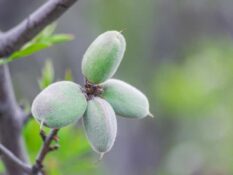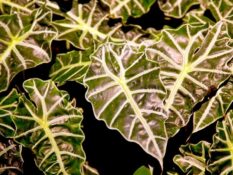Propagate | Soil | Light | Water | Temperature | Humidity | Potting | Pruning | Fertilize | Pest Control | FAQs
Alocasia tiny dancer is an evergreen perennial plant native to South East Asia. The plant gets its name from the unique shape of its leaves, which resemble dancing figures. Alocasia tiny dancer features large, arrow-shaped leaves with pointed tips and creamy yellow veins running along their edges. It is a low-growing plant, reaching up to a maximum of just one foot in height, and produces small white flowers.
Alocasia tiny dancer plants are easy to care for, requiring minimal attention. They prefer moist soil that is rich in nutrients and requires regular fertilization. Alocasia tiny dancer also thrives best when grown in indirect sunlight and kept relatively humid. This guide will give you all the information you need to grow and care for your Alocasia tiny dancer plant.
Do Alocasia tiny dancer flower? What color is the Alocasia tiny dancer flower?
Yes, Alocasia tiny dancer produces small white flowers. The flowers are characterized by their cone-shaped petals and faint sweet scent. They typically emerge in the summertime and last until fall or early winter. While these blooms are beautiful, they don't produce any fruit or seed, so you will need to propagate them via rhizomes or by taking root cuttings.
When to plant Alocasia tiny dancer plant?
Alocasia tiny dancer is best planted during the spring or summer when temperatures are warm and the soil is moist. Plant them in a well-draining, nutrient-rich potting mix, and place them in an area that receives indirect sunlight.
Types of Alocasia tiny dancer: what are the recommended varieties of Alocasia tiny dancer plants?
There are several varieties of Alocasia tiny dancer plants, including the standard plant (Alocasia tiny dancer 'Tiny Dancer'), the Dwarf variety (Alocasia tiny dancer 'Dwarf'), and the Giant variety (Alocasia tiny dancer 'Giant'). All of these varieties are easy to grow and require similar care.
Alocasia tiny dancer soil requirements: What is the best soil for the Alocasia tiny dancer plants?
Alocasia tiny dancer plants prefer a rich, well-draining potting mix. The ideal soil should be composed of two parts peat moss, one part perlite, and one part compost. When planting Alocasia tiny dancer in containers, ensure that the potting mix is light and airy.
Adding amendments and enhancers can also improve the soil structure and nutrient content. For example, slow-release fertilizer, worm castings, or compost can help ensure that your Alocasia tiny dancer plants receive the nutrition they need to thrive.
Alocasia tiny dancer light requirements: How much light does Alocasia tiny dancer plant need?
Alocasia tiny dancer plants prefer bright, indirect sunlight. Place them in a location that receives at least four to six hours of indirect light daily. A small amount of direct sunlight is also beneficial, but too much can cause the leaves to burn or turn yellow.
Plant grow light can also supplement the light needs of your Alocasia tiny dancer plant. Ensure to provide your plant with a minimum of 12 hours of light and 12 hours of darkness each day.
Alocasia tiny dancer water requirements: How often to water the Alocasia tiny dancer plant?
Alocasia tiny dancer plants prefer to stay evenly moist but not soggy. Water them whenever the top inch of soil feels dry, and adjust, the frequency based on your particular environmental conditions. It's best to avoid overwatering, as this can lead to root rot or fungal diseases.
An irrigation system can also ensure that your Alocasia tiny dancer plants stay lush and healthy. Using a timer will help ensure that your plants receive consistent watering and will help you save time in the process.
Alocasia tiny dancer temperature range: What temperature can Alocasia tiny dancer tolerate?
Alocasia tiny dancer plants can tolerate temperatures between 65-85°F (18-29°C). They are not frosted tolerant, so bring them indoors or provide them with a frost cloth during cold weather.
To protect plants during bad weather, You can use a greenhouse, cold frame, and plant protective covers to maintain the optimal temperature for your Alocasia tiny dancer plants.
Alocasia tiny dancer humidity: Do Alocasia tiny dancers like humidity?
Alocasia tiny dancer plants prefer high humidity levels between 50-70%. You can maintain a humid environment by misting your plant with water and using a pebble tray. A humidifier can also increase the humidity levels in your home or outdoor garden.
To maintain the humidity of plants around your Alocasia tiny dancer, you can use large containers of water, group plants together, or even grow them in a terrarium.
Alocasia tiny dancer plant propagation: How to propagate Alocasia tiny dancer plant?
Several methods of propagating plants include division, stem cuttings, and tissue culture.
Propagating Alocasia tiny dancer plant by cutting
Alocasia tiny dancer plants can be propagated easily by taking stem cuttings. Choose a healthy stem with at least three leaves and remove the bottom two leaves. Place the cutting in a container with well-draining soil and water it until the top inch of the soil feels moist. Place the container in bright, indirect light and wait for new roots to form. Once established, you can transplant the cutting into a larger pot or garden bed.
Propagating Alocasia tiny dancer plant by division
The division is another method of propagation that can be used to propagate Alocasia tiny dancer plants. To divide an Alocasia tiny dancer plant, gently remove it from its pot and separate the clump into smaller sections. Each section should have a few leaves and plenty of root systems. Replant each section into smaller containers and keep them in bright, indirect light. Water the divisions regularly and wait for them to establish before transplanting them into a larger pot or garden bed.
Propagating Alocasia tiny dancer plant by tissue culture
Tissue culture is a method of cloning plants by taking small pieces of tissue from the mother plant and growing them in sterile containers. This method is suitable for plants that are difficult to propagate by stem cuttings or division. You can have tissue culture done professionally or attempt it yourself.
Potting Alocasia tiny dancer plant
Alocasia tiny dancer plants should be planted in well-drained and nutrient-rich potting soil. You can use a commercial potting mix or make your mixture with equal parts peat moss, compost, and perlite. Fertilize your plants every few weeks with a balanced fertilizer to keep them healthy and looking good.
When transplanting Alocasia tiny dancer plants, make sure not to plant them too deep in the pot, as this can cause root rot. When planting them in the ground, dig a larger hole than necessary and add some compost or aged manure to the soil to provide essential nutrients. Mulch the surrounding soil to help retain moisture and keep weeds at bay.
It is important to select the correct pot size or container for your Alocasia tiny dancer plants. A pot that is too small will cause root rot and inhibit growth, while a pot that is too large.
How to prune Alocasia tiny dancer plant?
Pruning is essential to keeping your Alocasia tiny dancer plant healthy and looking good. Pruning helps keep the plant in shape and encourages new growth. Prune Alocasia tiny dancer plants regularly, removing dead or diseased foliage and long stems hanging over the pot's edge.
You can use shears or a small pair of scissors to prune your Alocasia tiny dancer plant. Make sure to disinfect your tools before and after each use to prevent the spread of disease. Prune your plant in late winter or early spring, when it is actively growing, for the best results.
How to fertilize Alocasia tiny dancer plant?
Fertilize your Alocasia tiny dancer plant regularly to keep it looking its best. A balanced fertilizer with a ratio of 8-10-8 is ideal for these plants. Fertilize every two weeks during the growing season, using half the recommended amount of fertilizer. In winter, reduce the frequency of fertilizing to once a month.
Choose a high-quality fertilizer with a balanced NPK (nitrogen, phosphorus, and potassium) ratio to fertilize your Alocasia tiny dancer. Some of the plants also benefit by adding appropriate soil amendments.
Common Alocasia tiny dancer diseases and how to manage Alocasia tiny dancer disease?
Alocasia tiny dancer plant is prone to a few common pests and diseases, including:
- Root rot – This is caused by overwatering, poor drainage, or planting in a pot that is too small. Treatment involves removing the affected roots and repotting them in fresh, well-draining soil.
- Fungal diseases – These are caused by fungi that thrive in wet and humid environments. Treatment involves removing affected leaves and applying a fungicide to prevent further spread.
- Aphids – These small insects suck the sap from the plant, causing leaves to turn yellow and drop. Treatment involves spraying with a horticultural soap solution and repeating as necessary.
- Spider mites – These small spider-like insects feed on the underside of leaves, causing them to turn yellow and curl. Treatment involves spraying the plant with horticultural oil or insecticidal soap.
In case of an outbreak, Use good quality insecticides and fungicides to manage and treat the diseases. Read and follow label instructions carefully, and always use the products safely.
Ten reasons to grow Alocasia Tiny Dancer
1. Versatile and Attractive: Alocasia tiny dancer is a versatile and attractive plant that looks great in any home or garden.
2. Easy to Care: This plant requires minimal maintenance, making it ideal for beginners.
3. Beautiful Foliage: Alocasia tiny dancer has large, glossy leaves with unique patterns that make it an eye-catching addition to any space.
4. Low Maintenance: This plant needs little pruning and fertilizing, making it easy for busy individuals to keep up with its care requirements.
5. Adds Natural Beauty: The beauty of Alocasia's foliage can greatly enhance any indoor or outdoor space, creating a more natural atmosphere.
6 . Can Be Used as a Houseplant or Outdoors: The Alocasia tiny dancer can grow indoors or outside in warm climates.
7 . Long-Lasting Plant: This plant is very hardy and can survive for many years if given proper care.
8 . Air Purifying Properties: Alocasia tiny dancer plants help purify the air by absorbing harmful toxins such as formaldehyde, benzene, and trichloroethylene.
9 . Natural Insect Repellant: This plant's strong scent acts as a natural insect repellent.
10. Low Price Point: These plants are inexpensive compared to other houseplants, making them an ideal option for those on a budget.
Takeaway on how to grow and care for Alocasia tiny dancer
Alocasia tiny dancer is a versatile and attractive plant that adds natural beauty to any indoor or outdoor space. It's an easy-to-care-for plant that needs minimal maintenance, making it ideal for busy individuals. To keep your Alocasia tiny dancer looking its best, it's important to provide adequate fertilizer and water and monitor pests and diseases frequently. This beautiful specimen will remain healthy and vibrant for many years with proper care. The Alocasia tiny dancer is worth considering if you're looking for an attractive houseplant with low maintenance requirements!
Explore our plant grow and care guides collection if you want to add more plants to your garden.
If you're new to gardening or a seasoned pro, join our supportive AgFunnel community of gardeners. Share a picture of your garden and receive support from fellow plant lovers. Happy gardening.
FAQs
What is Alocasia tiny dancer?
Alocasia tiny dancer is a beautiful, versatile houseplant with large, glossy leaves with unique patterns. It's an easy-to-care-for plant that needs minimal maintenance, making it ideal for busy individuals.
Where to put Alocasia tiny dancer?
Alocasia tiny dancer can be grown indoors as a houseplant or outside in warm climates. Place it in an area that receives bright, indirect sunlight.
How often should Alocasia tiny dancer be watered?
Water your Alocasia tiny dancer when the top 1-2 inches of soil are dry. Do not let it sit in water; make sure the pot has drainage holes. During the winter, water is less often than in the summer.
How to get Alocasia tiny dancer to bloom?
Alocasia tiny dancer is a foliage plant and does not produce flowers. This plant is grown for its attractive foliage, not its blooms.
Does Alocasia tiny dancer plant like sun or shade?
Alocasia tiny dancer prefers bright, indirect sunlight. Place it in a spot that receives light but avoids direct sunlight, which can burn its leaves.
Is the Alocasia tiny dancer plant annual or perennial?
Alocasia tiny dancer is a perennial plant that will stay alive and healthy for many years if given proper care.
Does the Alocasia tiny dancer plant come back every year?
Yes, Alocasia tiny dancer is a perennial plant and will come back every year if given proper care.
Are Alocasia tiny dancer plants toxic to cats?
Yes, Alocasia tiny dancer plants are toxic to cats if ingested. If you have cats in your home, keeping this plant out of their reach is best.
Are Alocasia tiny dancer plants toxic to dogs?
Yes, Alocasia tiny dancer plants are toxic to dogs if ingested. If you have a dog in your home, keeping this plant out of their reach is best.
Are Alocasia tiny dancer plants toxic to pets?
Yes, Alocasia tiny dancer plants are toxic to pets if ingested. If you have pets in your home, keeping this plant out of their reach is best.
How cold can Alocasia tiny dancer plants tolerate?
Alocasia tiny dancer plants can tolerate temperatures of 50°F (10°C) or higher. To prevent cold damage, keep this plant indoors during cold weather and protect it from drafts.
How often to water the Alocasia tiny dancer plant?
Water your Alocasia tiny dancer when the top 1-2 inches of soil are dry. Do not let it sit in water; make sure the pot has drainage holes. During the winter, water is less often than in the summer.
When to stop watering the Alocasia tiny dancer plant?
Stop watering your Alocasia tiny dancer when the top 1-2 inches of soil are dry. Do not let it sit in water; make sure the pot has drainage holes. During the winter, water is less often than in the summer.
When to fertilize Alocasia tiny dancer plant?
Fertilize your Alocasia tiny dancer plant every two weeks during the growing season. Use a balanced liquid fertilizer and dilute it by half. During the winter, fertilize less often.
What Are the Similarities in Caring for Alocasia Tiny Dancer and Alocasia Frydek Plants?
Caring for Alocasia Tiny Dancer and Alocasia Frydek plants is similar in many ways. Both require well-draining soil, indirect sunlight, high humidity, and regular watering. These two varieties of the growing green velvet Alocasia plant also benefit from occasional fertilization and regular misting to keep their leaves looking lush and healthy.
Where to buy Alocasia tiny dancer plant?
Alocasia tiny dancer plants can be purchased at local garden centers, home improvement stores, and online. Make sure to inspect the plant for signs of pests or disease before bringing it home.

How to master gardening? Download these essential home and gardening ebooks today!













